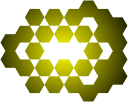Trihing Puzzles
These puzzles use the eight trihings. The pieces cover an area of 24 unit hexagons, but extra spaces must be enclosed. If solid pieces are used, patterns are considered symmetric regardless of the position of the bridges.
Geometric Forms
Use all the pieces to make a symmetric pattern. Here are examples for the different types of symmetry. Type of Symmetry
Horizontal Vertical
An oddity is a figure with binary symmetry formed by an odd number of copies of a polyform. Polyforms are compatible if there is a shape that can be tiled by each. You can find more about Polyform Oddities and Polyform Compatibility at George Sicherman's Polyform Curiosities website.
Di- and Trihing Puzzles
These puzzles use the eight trihings and the two dihings. The pieces cover an area of 28 unit hexagons, but extra spaces must be enclosed.
Geometric Forms
Use all the pieces to make a symmetric pattern. Here are examples for the different types of symmetry. Type of Symmetry
Double Bilateral Horizontal Vertical Birotary





